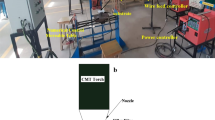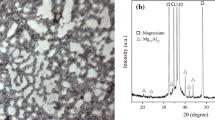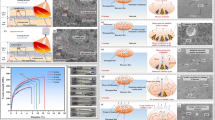Abstract
High porosity has been one of the main issues that limit the application of high-strength aluminum alloys produced by wire and arc additive manufacturing. This study attempts to reduce pores in 2219 aluminum alloys fabricated using double-electrode gas metal arc additive manufacturing (DE-GMA-AM). The effects of bypass current ratio on layer dimension, remelting area, and the number of pores were studied based on single-layer tests. Moreover, the influences of bypass current ratio on mean diameter, mean area, area percentage, radius ratio, and the number of porosities were investigated via depositing thin-walled parts. As the bypass current ratio increases, the layer height increases, and the layer width, the remelted area, and the number of the pores decrease. Pores are mainly distributed in the vicinity of the strips, and the quantity and area percentage in the middle region decrease first and then increase as the bypass current ratio increases. By increasing the bypass current ratio from 0 to 70%, the number of the pores and the area percentage in the middle region decrease by 68.6% and 72.6%, respectively. Porosity in the aluminum alloy parts fabricated using DE-GMA-AM can be significantly alleviated within a certain bypass current range.















Similar content being viewed by others
Availability of data and material
Not applicable.
Code availability
Not applicable.
References
Moradi M, Ashoori A, Hasani A (2020) Additive manufacturing of stellite 6 superalloy by direct laser metal deposition–Part 1: effects of laser power and focal plane position. Opt Laser Technol 131:106328. https://doi.org/10.1016/j.optlastec.2020.106455
Moradi M, Hasani A, Pourmand Z, Lawrence J (2021) Direct laser metal deposition additive manufacturing of Inconel 718 superalloy: statistical modelling and optimization by design of experiments. Opt Laser Technol 144:107380. https://doi.org/10.1016/j.optlastec.2021.107380
Moradi M, Hasani A, Beiranvand ZM, Ashoori A (2020) Additive manufacturing of stellite 6 superalloy by direct laser metal deposition–Part 2: effects of scanning pattern and laser power reduction in differrent layers. Opt Laser Technol 131:106455. https://doi.org/10.1016/j.optlastec.2020.106455
Li H, Yu Y, Li Y, Lin F (2022) Effects of the higher accelerating voltage on electron beam powder-bed based additive manufacturing of Ti6Al4V alloy. Addit Manuf 50:102579. https://doi.org/10.1016/j.addma.2021.102579
Åkerfeldt P, Antti ML, Pederson R (2016) Influence of microstructure on mechanical properties of laser metal wire-deposited Ti-6Al-4V. Mater Sci Eng A 674:428–437. https://doi.org/10.1016/j.msea.2016.07.038
Zhang C, Li Y, Gao M, Zeng X (2018) Wire arc additive manufacturing of Al-6Mg alloy using variable polarity cold metal transfer arc as power source. Mater Sci Eng A 711:415–423. https://doi.org/10.1016/j.msea.2017.11.084
Li Y, Xiong J, Yin Z (2019) Molten pool stability of thin-wall parts in robotic GMA-based additive manufacturing with various position depositions. Robot Comput-Integr Manuf 56:1–11. https://doi.org/10.1016/j.rcim.2018.08.002
Bai JY, Yang CL, Lin SB, Dong BL, Fan CL (2016) Mechanical properties of 2219-Al components produced by additive manufacturing with TIG. Int J Adv Manuf Technol 86(1–4):479–485. https://doi.org/10.1007/s00170-015-8168-x
Qi Z, Cong B, Qi B, Sun H, Zhao G, Ding J (2018) Microstructure and mechanical properties of double-wire + arc additively manufactured Al-Cu-Mg alloys. J Mater Process Technol 255:347–353. https://doi.org/10.1016/j.jmatprotec.2017.12.019
Gu J, Ding J, Williams SW, Gu H, Bai J, Zhai Y, Ma P (2016) The strengthening effect of inter-layer cold working and post-deposition heat treatment on the additively manufactured Al–6.3 Cu alloy. Mater Sci Eng A 651:18–26. https://doi.org/10.1016/j.msea.2015.10.101
Qi Z, Cong B, Qi B, Zhao G, Ding J (2018) Properties of wire+ arc additively manufactured 2024 aluminum alloy with different solution treatment temperature. Mater Lett 230:275–278. https://doi.org/10.1016/j.matlet.2018.07.144
Ryan EM, Sabin TJ, Watts JF, Whiting MJ (2018) The influence of build parameters and wire batch on porosity of wire and arc additive manufactured aluminium alloy 2319. J Mater Process Technol 262:577–584. https://doi.org/10.1016/j.jmatprotec.2018.07.030
Boeira AP, Ferreira IL, Garcia A (2009) Alloy composition and metal/mold heat transfer efficiency affecting inverse segregation and porosity of as-cast Al–Cu alloys. Mater Des 30(6):2090–2098. https://doi.org/10.1016/j.matdes.2008.08.032
Ayarkwa KF, Williams S, Ding J (2015) Investigation of pulse advance cold metal transfer on aluminium wire arc additive manufacturing. Int J Rapid Manuf 5:44–57
Wang D, Lu J, Tang S, Yu L, Fan H, Ji L, Liu C (2018) Reducing porosity and refining grains for arc additive manufacturing aluminum alloy by adjusting arc pulse frequency and current. Materials 11(8):1344. https://doi.org/10.3390/ma11081344
Feng Y, He L, Wang K, Xuanyu E (2018) The effects of low frequency on the microstructure and mechanical properties of high-strength Al-Mg aluminum alloys by wire and double-pulsed arc additive manufacturing. J Mater Eng Perform 27(11):5591–5604. https://doi.org/10.1007/s11665-018-3710-2
Gu J, Ding J, Williams SW, Gu H, Ma P, Zhai Y (2016) The effect of inter-layer cold working and post-deposition heat treatment on porosity in additively manufactured aluminum alloys. J Mater Process Technol 230:26–34. https://doi.org/10.1016/j.jmatprotec.2015.11.006
Zhang C, Gao M, Zeng X (2019) Workpiece vibration augmented wire arc additive manufacturing of high strength aluminum alloy. J Mater Process Technol 271:85–92. https://doi.org/10.1016/j.jmatprotec.2019.03.028
Bai JY, Fan CL, Lin SB, Yang CL, Dong BL (2017) Mechanical properties and fracture behaviors of GTA-additive manufactured 2219-Al after an especial heat treatment. J Mater Eng Perform 26(4):1808–1816. https://doi.org/10.1007/s11665-017-2627-5
Fang X, Zhang L, Li H, Li C, Huang K, Lu B (2018) Microstructure evolution and mechanical behavior of 2219 aluminum alloys additively fabricated by the cold metal transfer process. Materials 11(5):812. https://doi.org/10.3390/ma11050812
Zhang YM, Jiang M, Lu W (2004) Double electrodes improve GMAW heat input control. Weld J 83(11):39–41
Lu Y, Chen SJ, Shi Y, Li XR, Chen JS, Kvidahl L, Zhang YM (2014) Double-electrode arc welding process: principle, variants, control and developments. J Manuf Process 16:93–108. https://doi.org/10.1016/j.jmapro.2013.08.003
Yang D, He C, Zhang G (2016) Forming characteristics of thin-wall steel parts by double electrode GMAW based additive manufacturing. J Mater Process Technol 227:153–160. https://doi.org/10.1016/j.jmatprotec.2015.08.021
Yang D, Wang G, Zhang G (2017) A comparative study of GMAW-and DE-GMAW-based additive manufacturing techniques: thermal behavior of the deposition process for thin-walled parts. Int J Adv Manuf Technol 91(5–8):2175–2184. https://doi.org/10.1007/s00170-016-9898-0
Ahsan MR, Kim YR, Ashiri R, Cho YJ, Jeong C, Park YD (2016) Cold metal transfer (CMT) GMAW of zinc-coated steel. Weld J 95(4):120S-132S
Ding Y, Muñiz-Lerma JA, Trask M, Chou S, Walker A, Brochu M (2016) Microstructure and mechanical property considerations in additive manufacturing of aluminum alloys. MRS Bull 41(10):745–751. https://doi.org/10.1557/mrs.2016.214
Bai JY, Fan CL, Yang CL, Dong BL (2016) Effects of thermal cycles on microstructure evolution of 2219-Al during GTA-additive manufacturing. Int J Adv Manuf Technol 87(9–12):2615–2623. https://doi.org/10.1007/s00170-016-8633-1
Balla VK, Das M, Mohammad A, Al-Ahmari AM (2016) Additive manufacturing of γ-TiAl: processing, microstructure, and properties. Adv Eng Mater 18(7):1208–1215. https://doi.org/10.1002/adem.201500588
Cong B, Qi Z, Qi B, Sun H, Zhao G, Ding J (2017) A comparative study of additively manufactured thin wall and block structure with Al-6.3%Cu alloy using cold metal transfer process. Appl Sci Basel 7(3):275–286. https://doi.org/10.3390/app7030275
Wu CS, Zhang MX, Li KH, Zhang YM (2007) Numerical analysis of double-electrode gas metal arc welding process. Comput Mater Sci 39(2):416–423. https://doi.org/10.1016/j.commatsci.2006.07.004
Funding
This work was supported by National Natural Science Foundation of China, no. 51975491, no. 62173280, and no. 52075121; State Key Lab of Advanced Welding and Joining, Harbin Institute of Technology, no. AWJ-21M18; Sichuan Science and Technology Program, no. 2021JDRC0085, no. 2021JDRC0097, and no. 2020YFG0197; and the Fundamental Research Funds for the Central Universities, no. 2682021ZTPY086.
Author information
Authors and Affiliations
Contributions
Kun Zhang: methodology, formal analysis, writing—original draft; Jun Xiong: conceptualization, supervision, writing—review and editing; Guangchao Liu: data processing; Guangjun Zhang: investigation.
Corresponding author
Ethics declarations
Ethical approval
Not applicable.
Consent to participate
Yes.
Consent for publication
Yes.
Conflict of interest
The authors declare no competing interests.
Additional information
Publisher's Note
Springer Nature remains neutral with regard to jurisdictional claims in published maps and institutional affiliations.
Rights and permissions
About this article
Cite this article
Zhang, K., Xiong, J., Liu, G. et al. Role of bypass current on pores in double-electrode gas metal arc additive manufactured 2219 aluminum alloy. Int J Adv Manuf Technol 121, 4503–4516 (2022). https://doi.org/10.1007/s00170-022-09686-z
Received:
Accepted:
Published:
Issue Date:
DOI: https://doi.org/10.1007/s00170-022-09686-z




